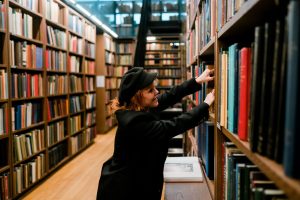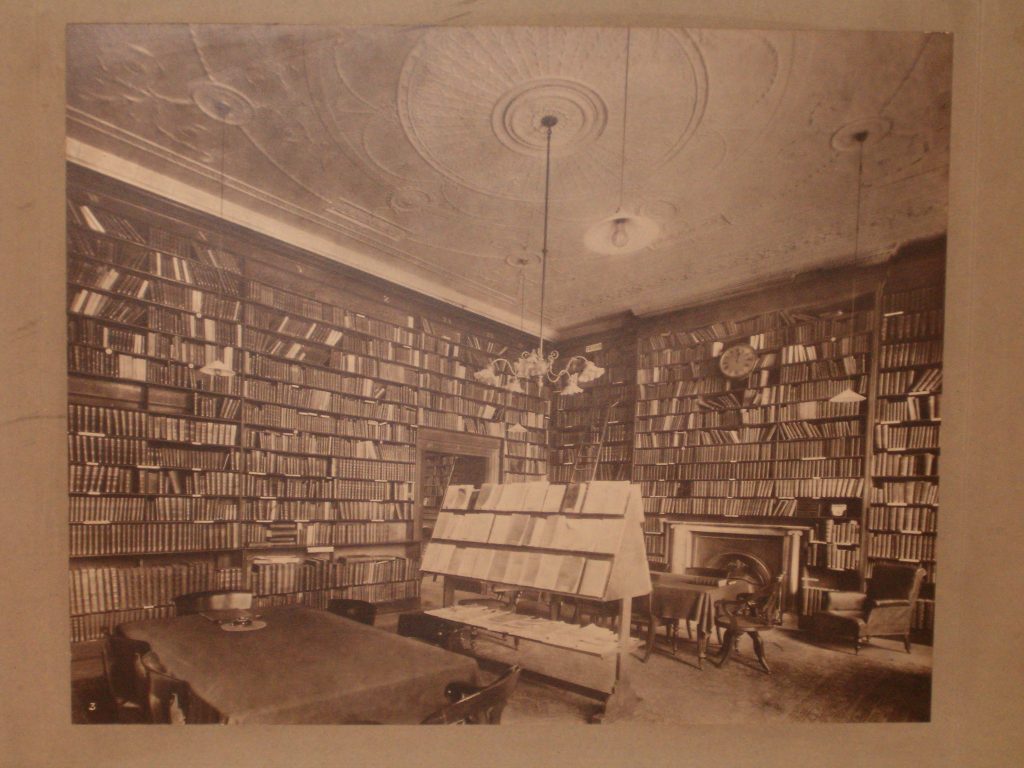Library of the Week: 8th August. This week we feature The London Library, one of the world’s greatest literary institutions and the world’s largest lending library. Find out more about the library and its history in this great post by The London Library.
Introduction
Tucked away in central London on St James’s Square, The London Library has been at the heart of literature since the day it was founded in 1841. Throughout our history, writers and researchers, no matter their genre or discipline, have consistently found the Library to be an unrivalled resource. Previous members have included TS Eliot, Mark Twain, Virginia Woolf, Harold Pinter, Charles Darwin, Charles Dickens, Bram Stoker, Muriel Spark, Paul Robeson, Stanley Kubrick, and Angela Carter. Current members include Sarah Waters, Kazuo Ishiguro, Raymond Antrobus, Stephen Fry, Inua Ellams, and Jessie Burton.
The London Library is an independent charity. Membership includes: access to our collection of around one million books and periodicals (almost all of which can be borrowed), a vast eLibrary, atmospheric workspaces in a beautiful building, a members suite, free nationwide postal loans, discounted tickets to the Library’s popular public events programme, and a number of member-run discussion groups, covering a diverse array of topics, covering everything from philosophy to history, gender studies to non-fiction writing.
The London Library is a home for everyone who loves the written word. We’re an independent charity and memberships start from less than £24 per month. Find out how to join our community or subscribe to our newsletter.
Background
Established at a time when there were no lending libraries in London and before state-funded libraries existed, The London Library’s starting collection of 2,000 books were handpicked by Gladstone, John Stuart Mill and the Italian revolutionary Mazzini. Charles Darwin joined within months of The Library opening, and William Thackeray joined soon after. Prince Albert donated £50 along with several books and became the Library’s first patron. Today HM The Queen is the Patron and the current President is Sir Tim Rice.

One of the most adored things about The London Library’s collection is the unique shelfmark scheme, which was developed by Librarian Charles Hagberg Wright (Librarian from 1893-1940) and is still used today. The entire collection is organised by subject and has been progressively adapted over the decades. The classification system now involves around 3,000 subject categories. It is a wonderfully serendipitous system and there is much delight to be found in the arcane categories and unexpected juxtapositions – especially in the much-loved Science & Miscellaneous section, where ‘Death’ and ‘Dentistry’ sit side by side, and ‘Flax’, ‘Flagellation’ and ‘Flower Arrangement’ are unexpected neighbours.
The building has expanded and been remodelled over the years to house the ever-growing collection. In 1896-1898 the building was entirely reconstructed with the creation of the iron framed and grille-floored back stacks making it one of the first steel-framed buildings in London. It was further extended in 1921, adding floors to house a further 200,000 books. In 1932 an adjacent building was purchased, and the library extended to create The Art Room, a committee room, more book stacks to house the approximately 450,000 volumes. Unfortunately, in 1944 the Library was hit by a German Wartime bomb and over 16,000 volumes were destroyed. It took 10 years to complete repairs to the 1930’s stacks.
The building has expanded two further times, with the Anstruther Wing completed in 1995 (allowing for the safe housing of 30,000 of the rarest and most vulnerable volumes held by The Library) and the purchase of Duchess House in 2004, which increased the overall capacity of the building by 30%.
The collection
The London Library is the world’s largest lending library. We now hold a collection of nearly 1,000,000 volumes, covering around 3,000 subjects in 55 different languages. Books range in date from 1500 to the present day, and these are complemented by over 2,000 periodicals dating from 1699 to the present. The London Library’s eResources and eBooks are a key benefit of Library membership. With more than 25,000 fully searchable information sources, the online collection is a library in its own right. The Library adds approximately 6,000 new physical titles to its collection each year.

In addition to four beautiful reading rooms, The Library also houses two dedicated collection rooms. The Art Room houses around 49,000 titles from the Library’s 450,000-strong art collection. Books held in the Art Room vary in sizes, with most being 4to. and small folio, and subjects range from Art History to Life Drawing, Projection Art to Aesthetics.
The Library’s labyrinthine basement area contains backruns of over 2,200 periodicals and journals housed on special rolling stacks. Also in the basement is The Times Room – a purpose-built facility providing open access to original copies of over 200 years of The Times newspaper, from the year it was founded in 1785, up to the end of 2000. Subsequent issues are available through the eLibrary.
In March 2022 a 21-year project to retro catalogue the collection was completed allowing us to make more of our rare and unique items discoverable via the online catalogue for the first time. At the end of 2017 only 75% of our collections were visible on the online catalogue. Now, that figure is around 95%.
Special collections
The London Library holds several special collections of material, including around 12,000 antiquarian books, dating from as early as 1500, which are housed in safe storage because of their age and rarity. In addition, just over 5300 books published from 1800 onwards are kept in safe storage due to their rarity, vulnerability, or unique provenance.
Included in these collections is a copy of Goethe’s Theory of Colour, translated by Charles Eastlake and published by John Murray in 1840. This work was influential among artists of the day and this English translation was well received. The Library’s copy has special significance for us as it is believed to be the first book that was borrowed when the newly founded Library opened its doors on 3rd May 1841.
The Library is also proud to have in its collection one of only 425 copies ever made of the Kelmscott Chaucer. Produced in 1896 by William Morris’s Kelmscott Press, this lavish pre-Raphaelite depiction of Chaucer’s Canterbury Tales features 87 woodcut illustrations and 116 full page plates by Edward Burne-Jones with elaborate bordering and initial letters designed by Morris himself. The Library’s copy was beautifully bound in white pigskin by Doves Press with intricate blind tooling and elegant silver clasps.
A varied collection of Small Books can also be found at the Library. There are nearly 350 books, all under five inches tall, printed between the 16th and 20th centuries. Included are collections of James Joyce’s poetry, an original 1839 copy for Bradshaw’s Guide (the world’s first railway timetable) and some enticing miniatures (under three inches tall). The Fly’s Eye Dante of 1878 is the smallest version of the Dante’s Divina Commedia in the world.

Programmes, public events, and partnerships
In 2019, The London Library launched its flagship Emerging Writers Programme designed to support new and unpublished writers. The Programme offers writers at the start of their careers one year’s membership of The London Library alongside writing development masterclasses, literary networking opportunities, peer support and guidance on using the Library’s resources. Every year, The London Library is proud to publish work from participants of The Emerging Writers Programme in an anthology titled New Voices Rise. Each volume showcases an exciting array of bright new talent, featuring contributions spanning prose to poetry, non-fiction to YA, stage to screen.
Many previous members of the Programme have gone on to publish (or will soon publish) work, including but not limited to, Amber Medland, Wild Pets (Faber), Abi Daré, The Girl with the Louding Voice (Penguin Random House), and Lianne Dillsworth, Theatre of Marvels (Penguin Random House).
Membership to The London Library also includes discounts on our public events programme. Running throughout the year, both in-person and online, previous events have included everything from book launches to literary salons, writing workshops and award ceremonies, to R.A.P parties.
In May 2021, we hosted The London Library’s 180th anniversary LitFest – an online festival that featured fifty-one speakers, including Salman Rushdie, Sarah Waters, and a staged adaption of A Room of One’s Own with Nina Sosanya. The festival was shortlisted in the FutureBook Awards 2021 Events category.
The Library is delighted to be able to partner with many different and

wonderful organisations and prizes, too, to support and celebrate writing talent. Our partnerships include English PEN, The Sunday Times Charlotte Aitken Young Writer of the Year Award, the Women’s Prize for Playwriting, and the 2022 Jhalak Prize. Through these partnerships, the Library is able to welcome and nurture writing talent from a range of different backgrounds and disciplines, ensuring that The London Library remains one of the world’s greatest literary institutions.
Memberships and how to join The London Library
The London Library has provided a centre of creativity, inspiration, and ideas for over 180 years. From Sarah Waters to Kazuo Ishiguro, Virginia Woolf to Bram Stoker, The London Library is a home for everyone who loves the written word.
The London Library is an independent charity. We receive no regular external funding outside of one-off donations and membership fees.
There are a number of different membership types to choose from, including:
Individual (our standard full membership), Young Person’s (for applicants aged 16 to 29), Remote (full access to the eLibrary and other Library benefits) and Associate (or ‘part-time’ membership).
Find out more and join our community. We would love to welcome you.
You can explore the library’s collections on Discover and find further contact details on their Discover information page.
All images are copyright of The London Library, reproduced with kind permission of the copyright holder.


2 replies on “The London Library”
Great to learn more about this fantastic institution. Just wondering if this info is correct? “The Art Room houses around 49,000 titles from the Library’s 44,500-strong art collection”. Numbers don’t seem quite right.
Hi Grant – thanks for noticing the typo! We’ve now corrected it.